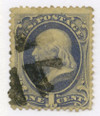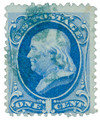
# 156 - 1873 1c Franklin, ultramarine
1873 1¢ Franklin
Continental Bank Note Printing
Earliest Known Use: August 22, 1873
Quantity issued: 448,290,000 (estimate)
Printed by: Continental Bank Note Company
Method: Flat plate
Watermark: None
Perforation: 12
Color: Ultramarine
Ben Franklin Appointed America’s First Postmaster General
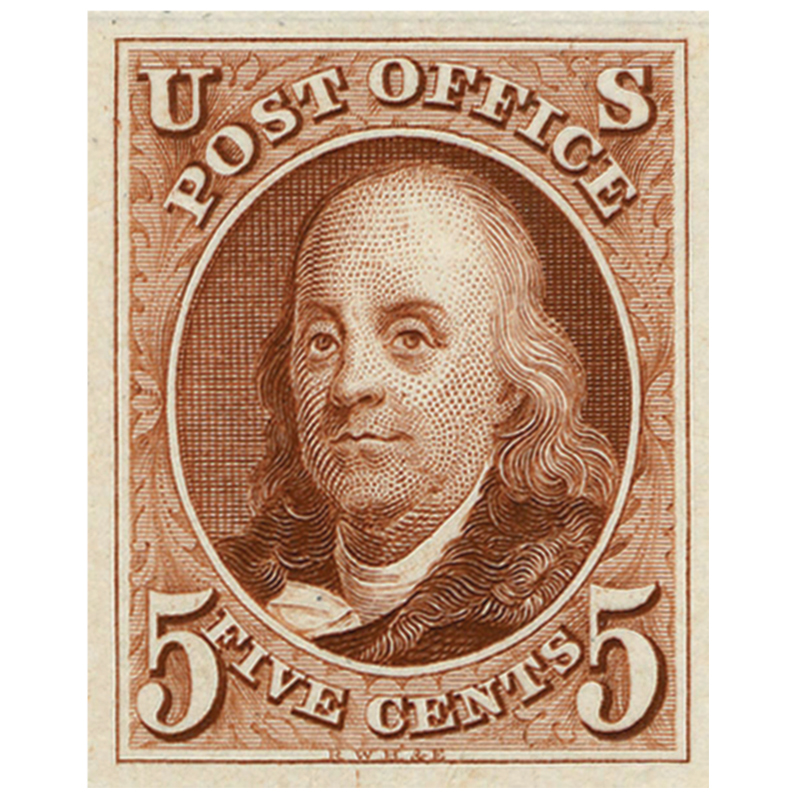
On July 26, 1775, former deputy postmaster general of the American colonies, Ben Franklin, was made the first postmaster general of the United States.
Benjamin Franklin (1706-90) was born in Boston, Massachusetts, and only attended school until the age of 10. He was an avid reader and quick learner. As a polymath (a person with expertise in a large number of areas), Franklin would eventually become an accomplished author, printer, freemason, scientist, inventor, activist, and statesman.
At the age of 17, Franklin ran away to Philadelphia, Pennsylvania, to seek his fortune. At that time, Philadelphia was the largest city in the American Colonies. Franklin flourished, and his accomplishments and contributions to the city earned him the title, “The First Citizen of Philadelphia.”
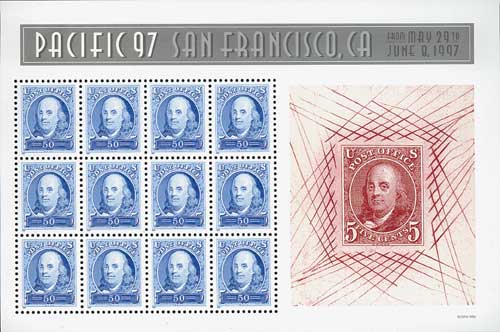
Franklin’s many contributions to the city of Philadelphia include: founding the first subscription library in the American Colonies; organizing the city’s fire department; law enforcement reform; leading efforts to pave, clean, and light public streets; raising money to build the Pennsylvania Hospital; and founding the academy that became the University of Pennsylvania.
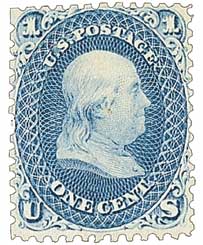
In 1753, Franklin was appointed deputy postmaster general of the American Colonies. He greatly improved the frequency and reliability of mail service. By 1761, the post office showed a profit for the very first time. Under Franklin’s supervision, the Colonial post office continued to be profitable for several years. But he was dismissed from the office in 1774 due to his views on Britain’s “taxation without representation.”
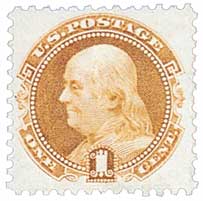
As America waged war with the United Kingdom in the summer of 1775, the need arose for an independent mail service, not controlled by the British. Because of long history with mail service in the colonies, Franklin was an obvious choice. On July 26, 1775, the Second Continental Congress established America’s first postal system and selected Benjamin Franklin as its first leader.
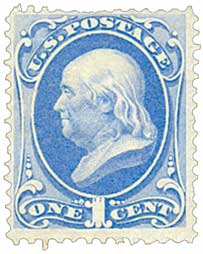
When he was made America’s first postmaster general, Franklin continued to revolutionize mail service in the colonies. He established routes between Florida and Maine, as well as regular service to and from Britain. Franklin also arranged for overnight postal travel between the major cities of New York and Philadelphia.
Additionally, Franklin set standardized rates based upon weight and distance that would remain in effect beyond his tenure. Though Franklin only held the office for a little over a year, his contributions were enormous and earned him the honor of being pictured on America’s first postage stamp.
Early Mail Service in the American Colonies
Postal service in the American colonies began in the early 1600s. Mail delivery was handled by informal and independently operated groups in larger cities. Boston established its first postal routes in 1639, followed by New York City in 1672.
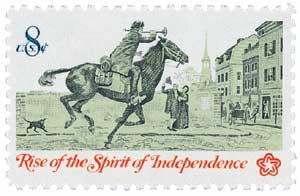
Then in 1692, King William III awarded a patent to an English nobleman to collect postal tax on official documents. The tax was only implemented for about a year before it was repealed.
In the coming decades, mail routes were established between Boston, New York, and Philadelphia. During this time, Franklin and others provided American colonists with a new option for mail delivery as many began to distrust the Crown Post. In fact, the mandatory purchase of stamps to pay taxes was eventually one of the causes of the American Revolutionary War.
Click here for a neat graphic showing the expansion of mail service through the U.S.
1873 1¢ Franklin
Continental Bank Note Printing
Earliest Known Use: August 22, 1873
Quantity issued: 448,290,000 (estimate)
Printed by: Continental Bank Note Company
Method: Flat plate
Watermark: None
Perforation: 12
Color: Ultramarine
Ben Franklin Appointed America’s First Postmaster General

On July 26, 1775, former deputy postmaster general of the American colonies, Ben Franklin, was made the first postmaster general of the United States.
Benjamin Franklin (1706-90) was born in Boston, Massachusetts, and only attended school until the age of 10. He was an avid reader and quick learner. As a polymath (a person with expertise in a large number of areas), Franklin would eventually become an accomplished author, printer, freemason, scientist, inventor, activist, and statesman.
At the age of 17, Franklin ran away to Philadelphia, Pennsylvania, to seek his fortune. At that time, Philadelphia was the largest city in the American Colonies. Franklin flourished, and his accomplishments and contributions to the city earned him the title, “The First Citizen of Philadelphia.”

Franklin’s many contributions to the city of Philadelphia include: founding the first subscription library in the American Colonies; organizing the city’s fire department; law enforcement reform; leading efforts to pave, clean, and light public streets; raising money to build the Pennsylvania Hospital; and founding the academy that became the University of Pennsylvania.

In 1753, Franklin was appointed deputy postmaster general of the American Colonies. He greatly improved the frequency and reliability of mail service. By 1761, the post office showed a profit for the very first time. Under Franklin’s supervision, the Colonial post office continued to be profitable for several years. But he was dismissed from the office in 1774 due to his views on Britain’s “taxation without representation.”

As America waged war with the United Kingdom in the summer of 1775, the need arose for an independent mail service, not controlled by the British. Because of long history with mail service in the colonies, Franklin was an obvious choice. On July 26, 1775, the Second Continental Congress established America’s first postal system and selected Benjamin Franklin as its first leader.

When he was made America’s first postmaster general, Franklin continued to revolutionize mail service in the colonies. He established routes between Florida and Maine, as well as regular service to and from Britain. Franklin also arranged for overnight postal travel between the major cities of New York and Philadelphia.
Additionally, Franklin set standardized rates based upon weight and distance that would remain in effect beyond his tenure. Though Franklin only held the office for a little over a year, his contributions were enormous and earned him the honor of being pictured on America’s first postage stamp.
Early Mail Service in the American Colonies
Postal service in the American colonies began in the early 1600s. Mail delivery was handled by informal and independently operated groups in larger cities. Boston established its first postal routes in 1639, followed by New York City in 1672.

Then in 1692, King William III awarded a patent to an English nobleman to collect postal tax on official documents. The tax was only implemented for about a year before it was repealed.
In the coming decades, mail routes were established between Boston, New York, and Philadelphia. During this time, Franklin and others provided American colonists with a new option for mail delivery as many began to distrust the Crown Post. In fact, the mandatory purchase of stamps to pay taxes was eventually one of the causes of the American Revolutionary War.
Click here for a neat graphic showing the expansion of mail service through the U.S.





